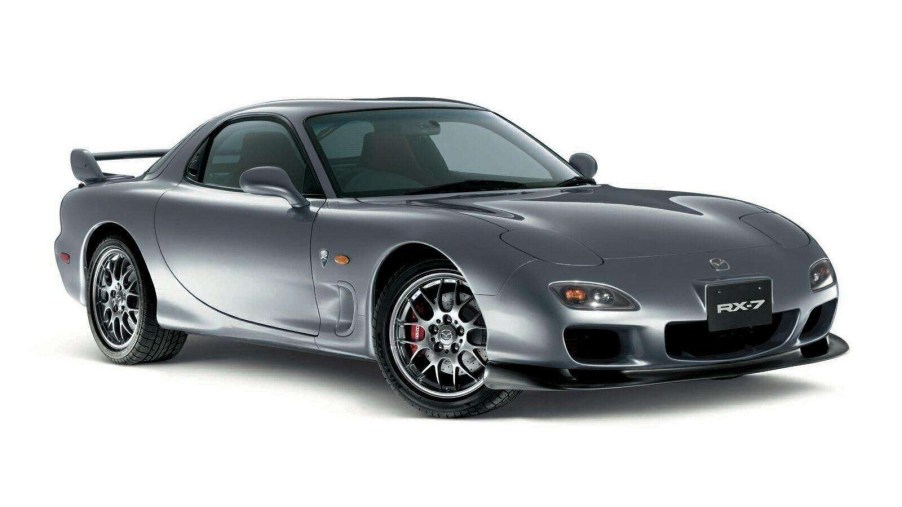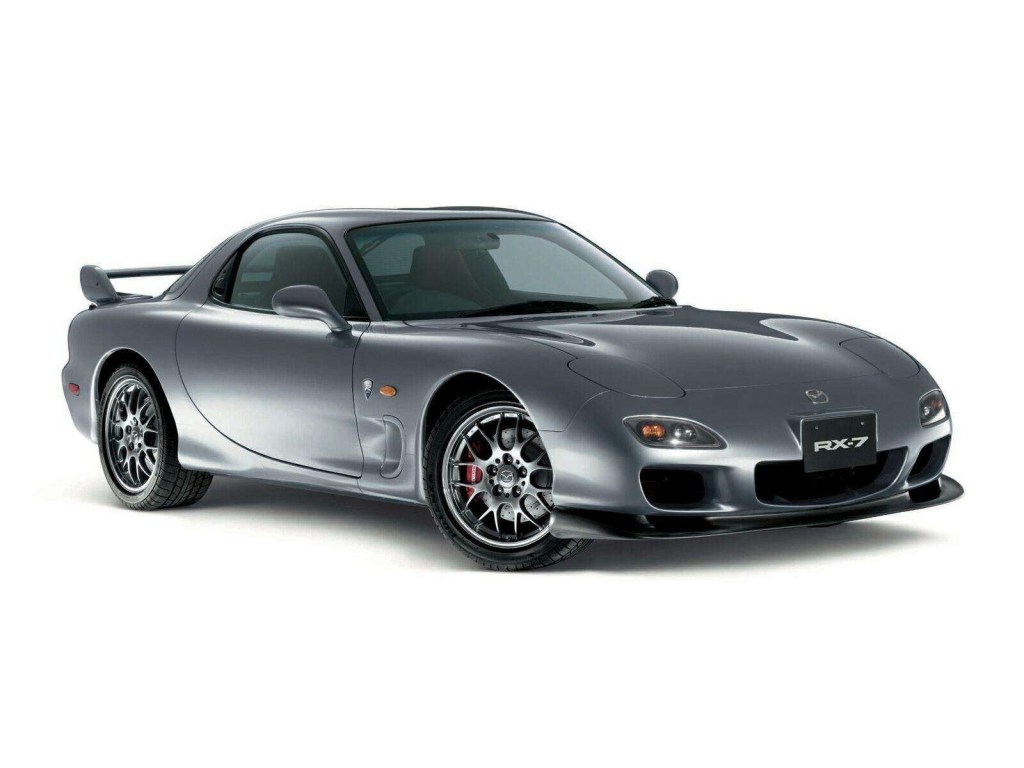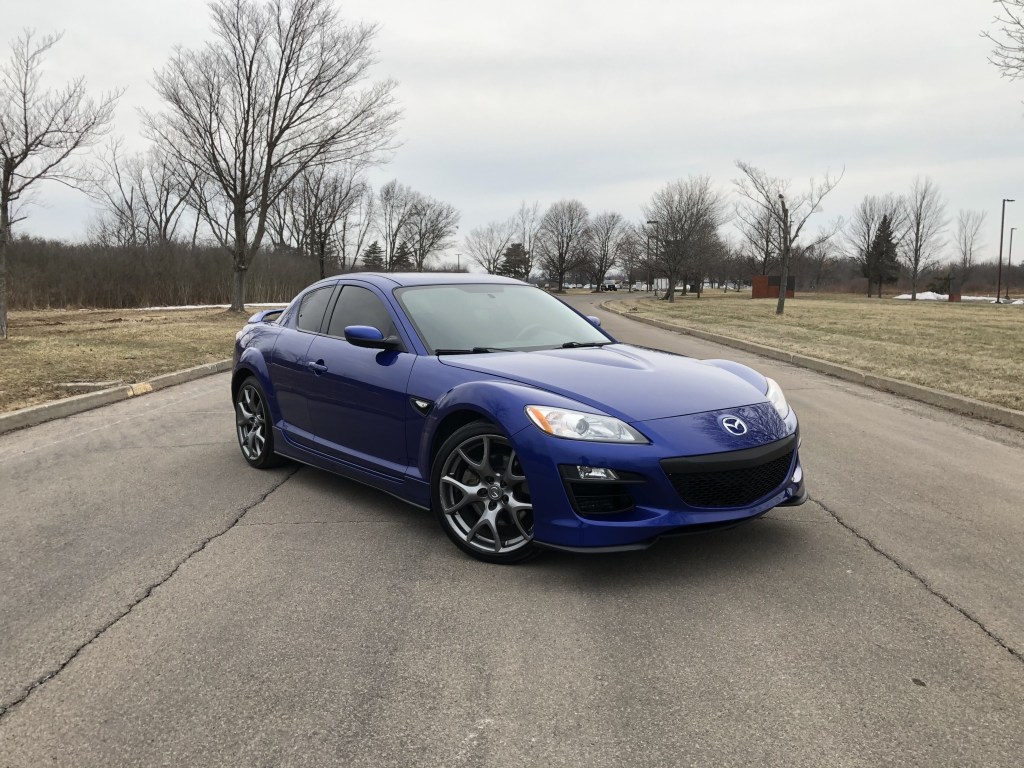
Why the Mazda RX7 Is Admired More Than the Newer RX8
Today, Mazda’s mostly known for stylish SUVs and the beloved MX-5 Miata. But the Japanese automaker has another claim to fame: its use of rotary cars. Up until 2019, Mazda was the only Japanese automaker to ever win Le Mans, and it did it with a rotary-powered car. A rotary engine powered one of the brand’s fastest cars, the Mazda RX7. But its successor, the Mazda RX8, never received the same level of fame and praise as the RX7. And unfortunately, that was mostly the rotary engine’s fault.
The Mazda RX-7’s popularity
As Donut Media explains, the Mazda RX-7 was actually the successor to a number of other rotary engine cars. Before it, Mazda had made the Cosmo sports car, as well as a whole line of other rotary-powered cars.
Rotary engines are lighter, smoother, and mechanically simpler than piston ones. They can also make more power per liter, which meant they could be more compact. All this resulted in the first-gen 1978-1985 ‘FB’ Mazda RX-7 having a low center of gravity and 50:50 weight distribution. This would continue for the second-gen 1985-1992 FC and third-gen 1993-2002 FD. These later gens, though, added even more performance.
The FC RX7 came with a 1.3-liter turbocharged 13B rotary, developing 189 hp. The later Turbo II model had an updated turbocharger design and air-to-air intercooler and made 200 hp. The FC was Motor Trend’s 1986 Import Car of the Year, with the Turbo II earning a spot on Car and Driver’s 10Best list. But it’s the FD that’s arguably the most beloved, Hagerty reports.

The FD Mazda RX7’s 1.3-liter 13B rotary now had twin sequential turbochargers. The smaller one spooled quickly, to boost low-RPM torque. The larger one came in later to boost power. All told, the FD put out 252 hp.
And, as r/cars sub-Reddit users point out, the FD came at the tail end of the Japanese Bubble Era, like the Nissan Skyline GT-R. This meant the 13B was in many ways overbuilt and could be reliably tuned for even more power. And, because this car starred in Initial D and Fast and Furious, many were.
Due to the RX7’s popularity, Mazda did create a successor, the 2003-2012 RX8. But despite its 232-hp naturally-aspirated 1.3-liter rotary, the RX8 never lived up to the RX7’s legend. And Mazda hasn’t made a production rotary engine since.
The Mazda RX8’s engine problems
The main issue, Jalopnik reports, is that the RX8’s ‘Renesis’ rotary wasn’t built quite like the RX7’s 13B. The Renesis engine’s housing isn’t as strong and can warp over time. In addition, Mazda had to modify the rotary engine’s exhaust to comply with emissions. But the biggest issue was with the apex seals.
As Popular Mechanics explains, instead of pistons, a rotary engine generates power via a rotating triangle, aka ‘the spinning Dorito.’ The triangle splits the housing into 3 spaces: one for intake, one for combustion, and one for exhaust.
As Engineering Explained’s Jason Fenske explains, a rotary engine needs good apex seals not just to keep the spaces separate, but because one side of the rotor is always hotter than the other side. Rotary engines are essentially constantly trying to warp their apex seals, and unfortunately, the Mazda RX8’s seals were lighter and thinner than the RX7’s.
2004-2008 Mazda RX8s suffered so many engine-related issues, Autoblog reports, that the automaker extended the cars’ warranties and reimbursed owners for repairs.
The RX7’s engine had its own problems
To be fair, the FD Mazda RX7’s 13B rotary isn’t exactly bulletproof. For one, as with every rotary engine, the 13B is noticeably less fuel-efficient than a piston engine. And Hagerty reports the RX7’s apex seals can also fail if treated improperly.
In addition, Hagerty reports the FD’s sequential-turbo setup caused its own headaches. Turbocharging the 13B like that generated so much heat, the catalytic converter could actually melt, The Straight Pipes report. There’s even a built-in warning light specifically to let the driver know the exhaust is heating up too much.
Not only could this cause the cabin to heat up, but it could also damage important engine components. Excess heat can make the turbos’ vacuum hoses, radiator hoses, and even wiring harnesses brittle. That can cause performance losses, fluid leaks and further heating problems, and electrical issues, respectively.
Furthermore, the Mazda RX7, like the RX8, suffered at the hands of owners who didn’t understand its unique maintenance requirements.
Rotary maintenance
Carefully-maintained, both the Mazda RX7 and RX8 can be very reliable. Jean-Pierre Derdeyn of rotary-specialist shop Derwin Performance told Hagerty that rotary engines can last for 150,000 miles or more without issue if maintained correctly.
First, as 5250 Performance explains, rotary engines shouldn’t be shut down cold. This creates flooding, which can cause the oil on the rotary walls to thin, causing excessive seal wear. In addition, revving a Mazda RX8 close to redline is actually beneficial. RX8 owner forum users report this is to help burn off excess carbon buildup, which can otherwise internal engine damage and corrosion.
But perhaps the most important difference between a piston and a rotary engine is with oil consumption. Rotary engines burn oil as a natural part of combustion, something normal synthetic oils aren’t really designed for. Instead, Derdeyn recommends using zinc-heavy conventional oil; some owners even modify their cars to accept two-stroke oil. Also, instead of changing the oil every 7500 miles, it should preferably be changed every 3000-5000 miles.
Are the Mazda RX8’s problems deal-breakers?
However, if a Mazda RX8 has been properly maintained, it does offer genuine benefits over the RX7.

For one, RX8s are significantly cheaper. One recently sold on Bring a Trailer for $10,750—and it was the sportier R3 model. Meanwhile, Hagerty reports the best stock Mazda RX7s can cost up to $34,500.
Also, unlike the RX7, the RX8 is a genuine 4-seat sports car. Car Throttle reports RX8s can seat 4 adults for long road-trips. And the handling is arguably even better than the FD’s.
Grassroots Motorsports recommends buying a 2009 or later RX8. Mazda improved the Renesis engine’s fueling and oil metering and installed a stronger 6-speed manual. The only other real issue, Super Street reports, is a somewhat-weak OEM ignition coil system. But that’s easily remedied with aftermarket parts. Black Halo Racing’s system even comes with a warranty.
So, while the Mazda RX7 may be an admired icon, that doesn’t mean the RX8 deserves all the vitriol it receives.
Follow more updates from MotorBiscuit on our Facebook page.


